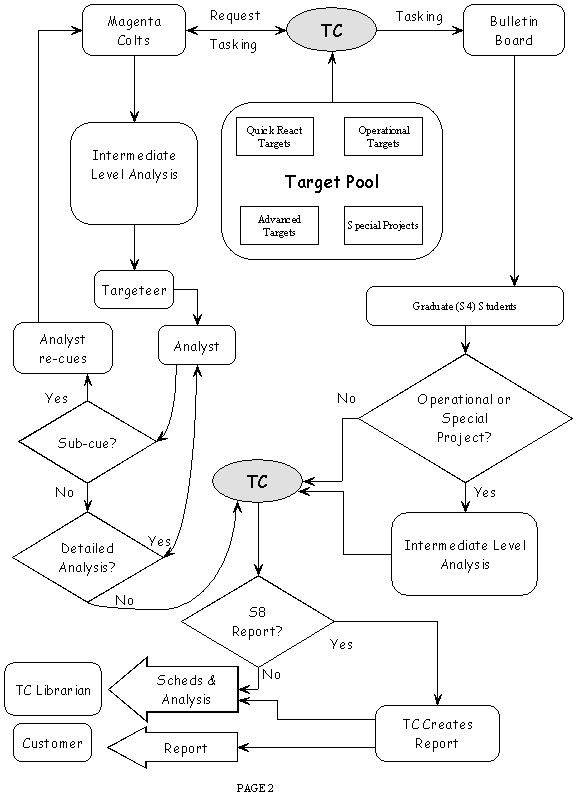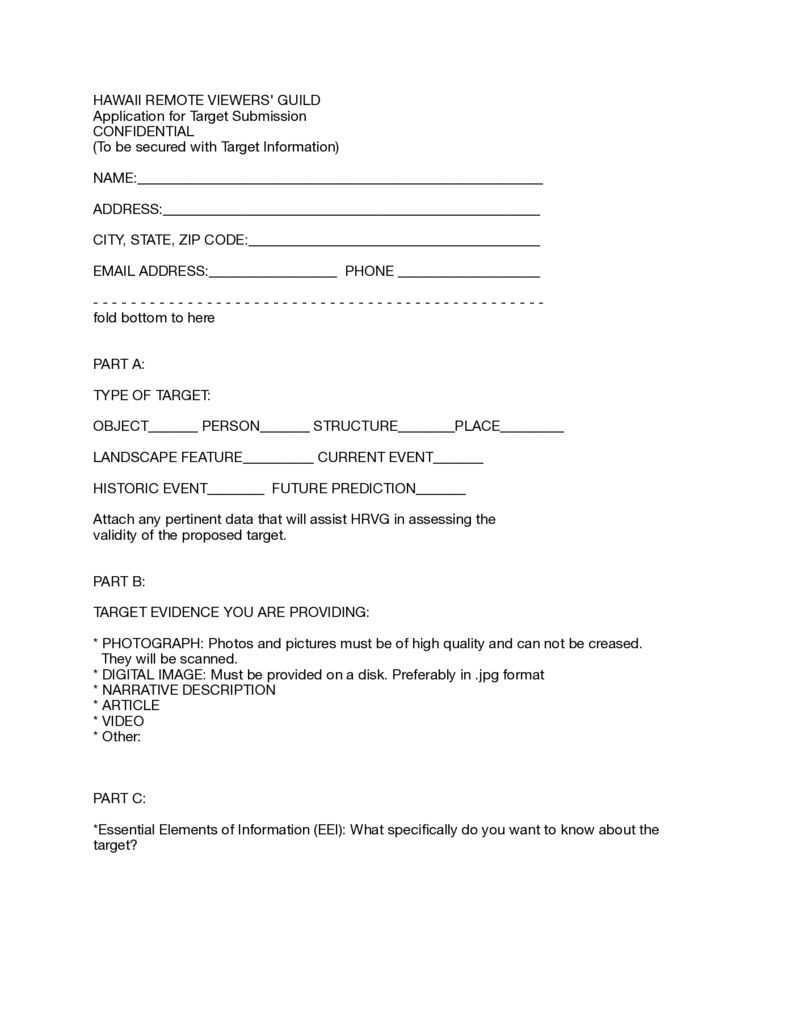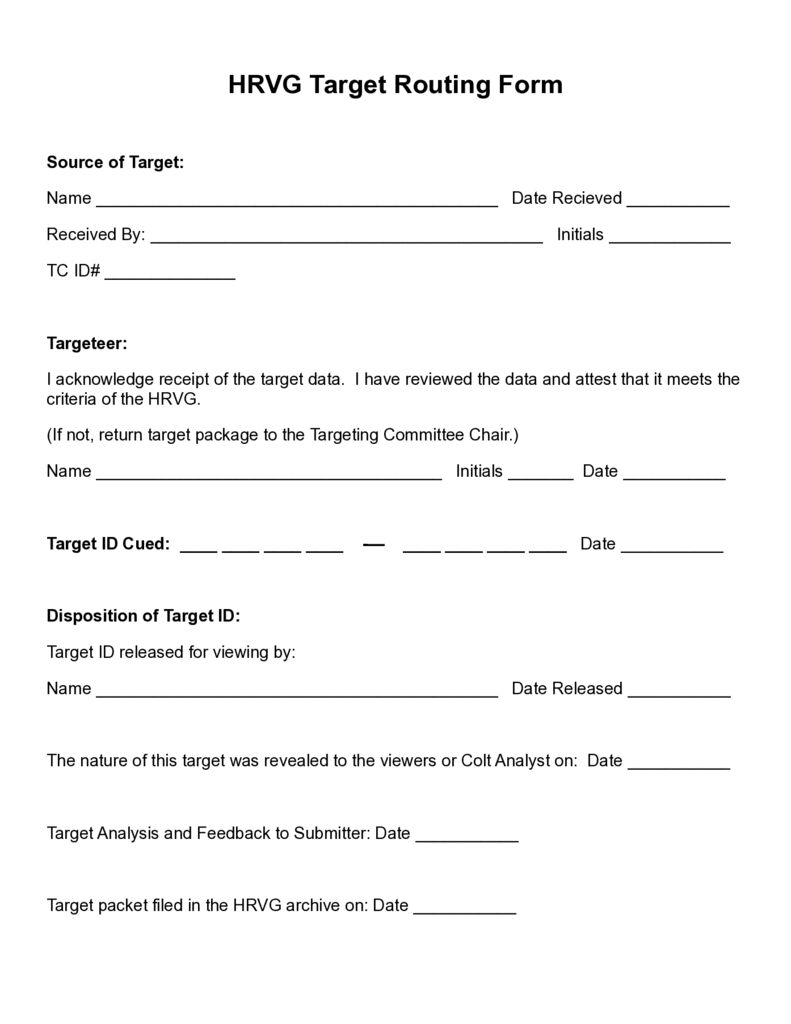The Important Role of the Guild’s Targeting Committee

Scope
The Targeting Committee creates, receives, qualifies, distributes, secures, analyzes, stores and reports remote viewing data for the HRVG.
Purpose
This is an operating instruction that details the actions undertaken by the HRVG Targeting Committee. It is to be used by targeteers, analysts and others to coordinate the operations of the HRVG Targeting Committee.
Targeting Committee Chair
The Targeting Committee Chair (TCC) is appointed by the HRVG Board of Directors and is responsible for the workings of the HRVG Targeting Committee (TC). The TCC establishes procedures to implement the scope of operations outlined above.
- The TCC reports to the HRVG board of directors at board meetings.
- The TC Librarian, Targeteers, and Analysts are under the direction of the TCC.
- The TC is the sole means to submit targets for viewing by the guild.
- The TCC provides the Target IDs used by targeteers to cue targets.
- The TCC assigns targets to be viewed by the guild, except for those generated in a class setting. In this case, the TCC retains quality control and reporting authority only.
Targeting Committee Librarian
The Targeting Committee Librarian (TCL) manages the physical repository of all work created by the guild. The TCL maintains the files of sessions and targets associated with those sessions. All completed work will be turned in to the TCL. All documents in the HRVG files are governed by administrative guidelines set up by the TCL.
Targeteers
The HRVG targeteers are selected from members of Magenta Colts. They are specially trained viewers that qualify targets submitted to the guild and assign target IDs. They provide the pool of targets that are worked by the guild. A Targeteer must pass a specialized training regime and be certified, before performing this task.
Targeteers may be tasked to post targets for general viewing on the HRVG website. Specialized instructions on how to do this will be provided by the HRVG Webmaster or other knowledgeable parties. In this role, the targeteer is responsible for not releasing the identity of a target prior to its release date. A Targeteer’s Checklist of administrative duties is included at the end of this instruction.
The Analysts
The Analyst receives completed session work and evaluates for data congruent with a target. This usually entails comparing, extracting and compiling data from multiple sessions to establish corroboration between viewers. The TCC assigns and directs analysts that perform this role. The Analyst may be a member of a Magenta Colt or specifically selected to analyze data from on a target of interest to the guild. An Analyst must pass a specialized training regime and be certified, before performing this task.
Submission of Targets
The process for HRVG Targets Submission is thoroughly explained on the HRVG website.
The Application Form for target submission can be found there and at the end of this document.
Targeteers will fill out an HRVG Routing Form which will accompany the target packet:
Workflow
The flow of targets into the guild and the sequence of activities leading to a final product are outlined in the flowchart at the end of this document.
Target Qualification
The targets that go in to the target pool will be broken down into four general categories:
Operational targets: These have qualities that distinguish them from general targets by reason of their immediacy, and importance. These would include targets pertaining to current events, or important persons and are primarily investigative in nature.
Validation targets: These are targets for which most or all of the elements are known and are used primarily to train remote viewers.
Low validation targets: These are targets that have little concrete information known about them. These are investigative or speculative in nature and lack the ability to verify the results contained in the remote viewing session.
Experimental targets: These are targets that can have some or all of the qualities of those above, but are primarily used to investigate and further our understanding of Remote Viewing. They are defined more by their use than by their content.
The above types of targets are a continuum. Some targets will share one, some or all of these aspects.
The category that a target falls into determines how it will be viewed and by whom. It also dictates what will be done with the raw data as regards analysis and reporting.
Generally speaking, operational targets will receive analysis and some degree of reporting, depending on the nature of the target and the client’s requirements.
Validation targets (Low and High) are generally not analyzed unless participants take it on themselves to conduct an analysis for their own satisfaction.
The handling of experimental targets will be dictated by the premise of the experiment.
Operational targets are for Magenta Colts and classes or groups of viewers that have advanced to S-4 Cascade.
Validation targets are given to RV students and made available to all viewers for training purposes.
Low validation targets are rarely used due to their speculative nature. Primarily, these would be targets of interest to certain individuals or small groups, who would undertake the work for personal enjoyment.
TC Identification Number
There are several key ideas that TC procedures are meant to implement:
1. No viewer will know what a target is prior to submitting his or her work.
2. Targeteers will not view targets they cue unless the Target ID has been altered to disguise its origin.
3. Analysts will not analyze sessions they have worked.
The TC ID number (not to be confused with the Target ID) answers the questions:
1. When did this target enter the chain of custody?
2. Who is the targeteer?
3. What viewers are these targets appropriate for?
Grid
It is the job of the targeteer to classify targets. Classification determines who views what and is an integral part of the TC ID number. The following grid will be used by HRVG Targeteers to classify targets:
| Colts QRT | S-4 BB | Adv. Val. | Basic Val. | Low Val. /Ex. | |
| < 72 Hrs | A1 | B1 | C1 Class | D1 Class | E1 |
| Weekly | A2 | B2 | C2 Home work | D2 Home Work | E2 |
| Short Term | A3 | B3 | E3 | ||
| Long Term | A4 | B4 | E4 |
Categories A & B designate Operational targets.
Category A designates Magenta Colt or a specially selected quick reaction team.
Category B designates viewers trained through S-4.
Categories C & D designate Validation targets.
Category C designates advanced Validation targets.
Category D designates basic Validation targets.
Category E designates Experimental, Esoteric or Low Validation targets.
Numerical Designators are urgency indicators:
1 = to 72 hours. This includes quick reaction targets or in class targets
2 = Weekly. This includes BB targets and weekly homework targets.
3 = Short term projects. This includes targets requiring analysis and reporting with no critical time constraints from the tasker.
4 = Long term/on-going projects. Large projects requiring large-scale analysis and reporting. A high probability of multiple sub-cues exists.
Having classified the target and cued it, the targeteer must then construct the TC ID number and report the TC ID Number and Target ID to the TCC.
The TC ID is composed of a date-time group of the year, month and day in the format YY/MM/DD followed by the initials of the targeteer, followed by it’s sequence in the targets cued for that day, followed by the classification.
For example, a target cued on January 2, 2000 by Dick Allgire which is the first target he cued for that day and which is classified as a validation target (C2) would have a TC ID of: 000102DA1C2.
Once reported, this becomes an official HRVG target.
The purpose of this complicated exercise is to enable the TCC to track the target and to assign it to the appropriate viewer(s) and analyst without violating the chain of custody.
Pools
Most targets end up in a target pool. The only targets that will be expended prior to going into a pool will be quick reaction targets, those targeteered for a specific viewer or team of viewers such as Magenta Colts who have been specifically designated as the viewing team, people that are working on private projects or teachers requiring a specific kind of target for their upcoming class.
To the greatest extent possible, targets should be chosen from the pool, not cued and used on an as-needed basis.
There should be sufficient targets in the pools so that those needing them will have an adequate supply. Good classification ensures that the person requiring a target will get something appropriate to their needs.
Distribution
There are three consumers of targets. These are the Magenta Colts, students and graduates that have completed the basic course of instruction through Cascade, and new students.
Magenta Colts are the primary viewing organ of the HRVG. All targets submitted to Magenta Colts will be analyzed and reported. Magenta Colts are the preferred recipients of operational targets.
Students that have completed Cascade are important assets. Their level of data collection is such that analysis can be done with good result. They can view operational targets as well as other targets presented by the guild.
Students in training. These are the pre-Cascade students. They will view validation targets almost exclusively.
Magenta Colts
Magenta Colts are the primary remote viewing body of the HRVG. They are composed of four viewers that have specific roles assigned which may rotate on a regular basis. These roles are Mission Manager, Viewer, Monitor and Analyst. For the purposes of the TCC, the most important member is the Mission Manager.
The Mission Manager receives targets from the TCC, organizes the Magenta Colt to work a target and presents the final product to the TCC. If additional work is needed, the TCC may have the target re-cued and re-worked.
The Magenta Colt is responsible for publishing. They are also responsible reporting, except in situations involving external customers.
Reporting
The TCC is responsible for creating a final report for customers of the guild that require it. This is known as S8 Reporting.
Official HRVG Target
The TCC will provide a target for the guild in general on a weekly basis. The intended audience for this target is all viewers trained through S4 Cascade and Magenta Colt members who are not currently working a target. The purpose is to provide interesting targets to the more advanced viewers. All viewers that have been trained to S4 have sufficient data collection skills to make contributions, especially when multiple viewers’ work is analyzed.
All operational targets will be analyzed that are worked in this forum. Validation targets may or may not be analyzed depending on available resources.
The weekly target will be posted on the HRVG Bulletin Board and feedback will be given as work is completed.
The HRVG Target Submission and Routing forms can be downloaded by selecting and image below.
Targeting Committee Flowchart

Targeteering Checklist
- The targeteer receives a target to be cued. An HRVG Target Application Form should accompany any target that is from an external source
- The targeteer reviews the target to see if it meets HRVG criteria for subject matter and that materials provided are useable. (Quality photo, digital image, etc.)
- The targeteer cues target using an approved TC Target ID.
- The targeteer qualifies the target using the TC Grid.
- The targeteer generates a TC ID.
- The targeteer secures the Target Application Form and materials in an opaque envelope. He or she the fills out a TC Routing Form which is attached to the outside of the package.
- The targeteer determines if this target is going to be used immediately by an HRVG instructor in a class, if it will be posted on the BB as homework, or if it will go in the pool.
- The targeteer e-mails the TC ID, Target ID and disposition of the target to the TCC at glenn@hrvg.org.
- The physical material will be given to the HRVG instructor that will be giving feedback to the students or held for feedback if this was a homework target. Under no circumstances will the target be revealed prior to sessions or session synopsis being turned in. Any sessions turned in after the exposure of the target to ANYONE, will be disqualified from publication.
If the target was cued for the pool, it will be secured in the HRVG office safe.

